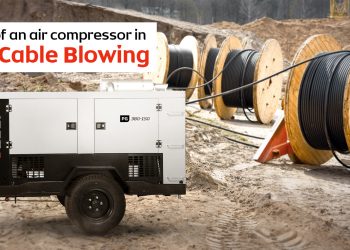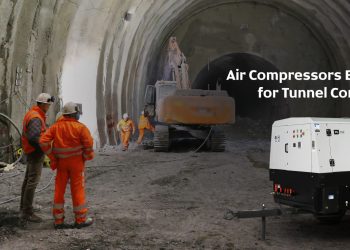Choosing an air compressor for automotive applications

The global automotive industry has undergone significant transformation over the past two decades. From the electrification of cars and two-wheelers, to self-driving and connected vehicles - technology is changing the way we drive and maintain our automobiles.
However, the basic vehicle manufacturing practice has largely remained the same. Different parts of a car, passing through production lines, are assembled by skilled workers or automated robotic processes. Air compressors are key devices that power the equipment used in vehicle assembly and the servicing and maintenance of finished products.
Choosing a suitable compressed air system for automotive applications depends on the volume and air pressure required for the concerned tools. These can vary widely across manufacturing plants and workshops:
Automotive production
In automobile manufacturing, air compressors are primarily used for:
- Operation of pneumatic robots
- Welding and plasma cutting
- Tyre inflation
- Driving machines that lift, move, position and fasten auto parts
- Body painting
You need to determine the total load profile of such applications to select an air compressor that can effectively power them. The factors that help in making correct calculations are:
- Review of historical power consumption records
- Checking the load on pneumatic systems
- Counting the number of equipment that need compressed air
- Being mindful of future plans for purchasing new compressed air operated machines and their collective requirement.
Such observations help determine the average airflow (CFM) and air pressure (bar ) required for daily operations, the maximum possible demand and requirement during a low production phase.
Automotive servicing and repair
Workshops need air compressors to paint vehicles, inflate tyres and operate equipment such as nibblers, power grinders, wrenches and sanders.
The amount of air volume essential to perform such tasks varies widely. While some processes need merely 2.5 CFM of airflow, there are others that demand 20 CFM or higher airflow from an air compressor. Usually, heavy-duty jobs such as sanding and painting have higher airflow requirements, whereas vehicle body cleaning and tyre inflation need lower volume.
In terms of pressure range, most air operated tools need 6.2 bar for proper functioning. Paint guns have a lower requirement, ranging between 2.4-4.1 bar. On the higher side, tyre inflation demands around 8.9 bar and truck jacks demand 11.4 bar.
Generally, air compressors with the highest standard operating pressure settings of7 bar, 8 bar, 10 bar or 12 bar can be used to manage the different mechanical tasks in automotive workshops.
You should also remember that air compressor systems offer higher airflow at low pressures and lower airflow at high pressures. Therefore, choosing the correct pressure is essential to ensure that you have an adequate airflow metric to power all your equipment. For example, if you have a tyre inflating machine that needs 8.9 bar while all other air tools need just 6.2 bar, consider buying a unit that can compress air to 10 bar or higher. Additionally, use a pressure regulator to help feed the air tools with the required 6.2 bar.
Applications that need oil-free air compressors in the automotive industry
In many pneumatic tool operations and applications such as tyre inflation, where a minor presence of oil particles is not detrimental to the job, an oil-lubricated air compressor serves the purpose. Also, modern oil-based air compressors come with custom filters and dryers that purify and drain the compressed air to keep the associated tools free from traces of oil and dirt.
However, when you need the air to be absolutely dry and clean, it is better to opt for oil-free air compressors tailored for specific industrial uses. The major applications that need oil-free compressed air systems in the automotive industry include:
Vehicle assembly – Pressurised air helps operate vehicle assembly robots and pneumatic equipment like nutrunners.
Car surface cleaning – Dirt-free and dry compressed air is used to clean the metal surface of a car’s body before coating it with paint.
Spray painting – Clean compressed air also enables spray painting through paint guns and robots onto the pre-cleaned surfaces of a vehicle’s body.
Using an oil-free air compressor for such processes, you will avoid damaging the equipment and costly replacements or downtime that follow such damage. In painting jobs, oil-free air compressors prevent the adhesion, beading and cracking of paint on the car’s surface to give a smooth and corrosion-free finish.
To sum up, while air compressors are the multitaskers of the automotive industry, choosing the right unit will depend on the existing scale of operations and your plans for expanding in the future.
At ELGi, we offer an array of air compressing systems for the automotive sector. Our products combine the benefits of high-efficiency, low-maintenance and environment-friendly functioning with best-in-class resilience. To know more about these units, visit https://www.elgi.com/in/air-compressor-automotive/







